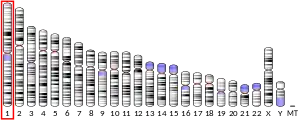NAD+ kinase
NAD+ kinase (EC 2.7.1.23, NADK) is an enzyme that converts nicotinamide adenine dinucleotide (NAD+) into NADP+ through phosphorylating the NAD+ coenzyme.[6] NADP+ is an essential coenzyme that is reduced to NADPH primarily by the pentose phosphate pathway to provide reducing power in biosynthetic processes such as fatty acid biosynthesis and nucleotide synthesis.[7] The structure of the NADK from the archaean Archaeoglobus fulgidus has been determined.[1]
| NAD+ kinase | |||||||||
|---|---|---|---|---|---|---|---|---|---|
 Ribbon diagram of NAD+ kinase in complex with substrates.[1] | |||||||||
| Identifiers | |||||||||
| EC number | 2.7.1.23 | ||||||||
| CAS number | 9032-66-0 | ||||||||
| Databases | |||||||||
| IntEnz | IntEnz view | ||||||||
| BRENDA | BRENDA entry | ||||||||
| ExPASy | NiceZyme view | ||||||||
| KEGG | KEGG entry | ||||||||
| MetaCyc | metabolic pathway | ||||||||
| PRIAM | profile | ||||||||
| PDB structures | RCSB PDB PDBe PDBsum | ||||||||
| Gene Ontology | AmiGO / QuickGO | ||||||||
| |||||||||
In humans, the genes NADK[8] and MNADK[9] encode NAD+ kinases localized in cytosol[8] and mitochondria,[9] respectively. Similarly, yeast have both cytosolic and mitochondrial isoforms, and the yeast mitochondrial isoform accepts both NAD+ and NADH as substrates for phosphorylation.[10][11]
Mechanism
NADK phosphorylates NAD+ at the 2’ position of the ribose ring that carries the adenine moiety. It is highly selective for its substrates, NAD and ATP, and does not tolerate modifications either to the phosphoryl acceptor, NAD, or the pyridine moiety of the phosphoryl donor, ATP.[8] NADK also uses metal ions to coordinate the ATP in the active site. In vitro studies with various divalent metal ions have shown that zinc and manganese are preferred over magnesium, while copper and nickel are not accepted by the enzyme at all.[8] A proposed mechanism involves the 2' alcohol oxygen acting as a nucleophile to attack the gamma-phosphoryl of ATP, releasing ADP.

Regulation
NADK is highly regulated by the redox state of the cell. Whereas NAD is predominantly found in its oxidized state NAD+, the phosphorylated NADP is largely present in its reduced form, as NADPH.[12][13] Thus, NADK can modulate responses to oxidative stress by controlling NADP synthesis. Bacterial NADK is shown to be inhibited allosterically by both NADPH and NADH.[14] NADK is also reportedly stimulated by calcium/calmodulin binding in certain cell types, such as neutrophils.[15] NAD kinases in plants and sea urchin eggs have also been found to bind calmodulin.[16][17]
Clinical significance
Due to the essential role of NADPH in lipid and DNA biosynthesis and the hyperproliferative nature of most cancers, NADK is an attractive target for cancer therapy. Furthermore, NADPH is required for the antioxidant activities of thioredoxin reductase and glutaredoxin.[18][19] Thionicotinamide and other nicotinamide analogs are potential inhibitors of NADK,[20] and studies show that treatment of colon cancer cells with thionicotinamide suppresses the cytosolic NADPH pool to increase oxidative stress and synergizes with chemotherapy.[21]
While the role of NADK in increasing the NADPH pool appears to offer protection against apoptosis, there are also cases where NADK activity appears to potentiate cell death. Genetic studies done in human haploid cell lines indicate that knocking out NADK may protect from certain non-apoptotic stimuli.[22]
References
- PDB: 1SUW; Liu J, Lou Y, Yokota H, Adams PD, Kim R, Kim SH (Nov 2005). "Crystal structures of an NAD kinase from Archaeoglobus fulgidus in complex with ATP, NAD, or NADP". Journal of Molecular Biology. 354 (2): 289–303. doi:10.1016/j.jmb.2005.09.026. PMID 16242716.
- GRCh38: Ensembl release 89: ENSG00000008130 - Ensembl, May 2017
- GRCm38: Ensembl release 89: ENSMUSG00000029063 - Ensembl, May 2017
- "Human PubMed Reference:". National Center for Biotechnology Information, U.S. National Library of Medicine.
- "Mouse PubMed Reference:". National Center for Biotechnology Information, U.S. National Library of Medicine.
- Magni G, Orsomando G, Raffaelli N (Jul 2006). "Structural and functional properties of NAD kinase, a key enzyme in NADP biosynthesis". Mini Reviews in Medicinal Chemistry. 6 (7): 739–46. doi:10.2174/138955706777698688. PMID 16842123.
- Pollak N, Dölle C, Ziegler M (Mar 2007). "The power to reduce: pyridine nucleotides--small molecules with a multitude of functions". The Biochemical Journal. 402 (2): 205–18. doi:10.1042/BJ20061638. PMC 1798440. PMID 17295611.
- Lerner F, Niere M, Ludwig A, Ziegler M (Oct 2001). "Structural and functional characterization of human NAD kinase". Biochemical and Biophysical Research Communications. 288 (1): 69–74. doi:10.1006/bbrc.2001.5735. PMID 11594753.
- Zhang R (Aug 2015). "MNADK, a Long-Awaited Human Mitochondrion-Localized NAD Kinase". Journal of Cellular Physiology. 230 (8): 1697–701. doi:10.1002/jcp.24926. PMID 25641397.
- Iwahashi Y, Hitoshio A, Tajima N, Nakamura T (Apr 1989). "Characterization of NADH kinase from Saccharomyces cerevisiae". Journal of Biochemistry. 105 (4): 588–93. doi:10.1093/oxfordjournals.jbchem.a122709. PMID 2547755.
- Iwahashi Y, Nakamura T (Jun 1989). "Localization of the NADH kinase in the inner membrane of yeast mitochondria". Journal of Biochemistry. 105 (6): 916–21. doi:10.1093/oxfordjournals.jbchem.a122779. PMID 2549021.
- Burch HB, Bradley ME, Lowry OH (Oct 1967). "The measurement of triphosphopyridine nucleotide and reduced triphosphopyridine nucleotide and the role of hemoglobin in producing erroneous triphosphopyridine nucleotide values". The Journal of Biological Chemistry. 242 (19): 4546–54. PMID 4383634.
- Veech RL, Eggleston LV, Krebs HA (Dec 1969). "The redox state of free nicotinamide-adenine dinucleotide phosphate in the cytoplasm of rat liver". The Biochemical Journal. 115 (4): 609–19. doi:10.1042/bj1150609a. PMC 1185185. PMID 4391039.
- Grose JH, Joss L, Velick SF, Roth JR (May 2006). "Evidence that feedback inhibition of NAD kinase controls responses to oxidative stress". Proceedings of the National Academy of Sciences of the United States of America. 103 (20): 7601–6. doi:10.1073/pnas.0602494103. PMC 1472491. PMID 16682646.
- Williams MB, Jones HP (Feb 1985). "Calmodulin-dependent NAD kinase of human neutrophils". Archives of Biochemistry and Biophysics. 237 (1): 80–7. doi:10.1016/0003-9861(85)90256-5. PMID 2982330.
- Lee SH, Seo HY, Kim JC, Heo WD, Chung WS, Lee KJ, Kim MC, Cheong YH, Choi JY, Lim CO, Cho MJ (Apr 1997). "Differential activation of NAD kinase by plant calmodulin isoforms. The critical role of domain I". The Journal of Biological Chemistry. 272 (14): 9252–9. doi:10.1074/jbc.272.14.9252. PMID 9083059.
- Epel D, Patton C, Wallace RW, Cheung WY (Feb 1981). "Calmodulin activates NAD kinase of sea urchin eggs: an early event of fertilization". Cell. 23 (2): 543–9. doi:10.1016/0092-8674(81)90150-1. PMID 6258805. S2CID 44821877.
- Lu J, Holmgren A (Jan 2014). "The thioredoxin antioxidant system". Free Radical Biology & Medicine. 66: 75–87. doi:10.1016/j.freeradbiomed.2013.07.036. PMID 23899494.
- Estrela JM, Ortega A, Obrador E (2006-01-01). "Glutathione in cancer biology and therapy". Critical Reviews in Clinical Laboratory Sciences. 43 (2): 143–81. doi:10.1080/10408360500523878. PMID 16517421. S2CID 8962293.
- Hsieh YC, Tedeschi P, Adebisi Lawal R, Banerjee D, Scotto K, Kerrigan JE, Lee KC, Johnson-Farley N, Bertino JR, Abali EE (Feb 2013). "Enhanced degradation of dihydrofolate reductase through inhibition of NAD kinase by nicotinamide analogs". Molecular Pharmacology. 83 (2): 339–53. doi:10.1124/mol.112.080218. PMC 3558814. PMID 23197646.
- Tedeschi PM, Lin H, Gounder M, Kerrigan JE, Abali EE, Scotto K, Bertino JR (Oct 2015). "Suppression of Cytosolic NADPH Pool by Thionicotinamide Increases Oxidative Stress and Synergizes with Chemotherapy". Molecular Pharmacology. 88 (4): 720–7. doi:10.1124/mol.114.096727. PMC 4576680. PMID 26219913.
- Dixon SJ, Winter GE, Musavi LS, Lee ED, Snijder B, Rebsamen M, Superti-Furga G, Stockwell BR (Jul 2015). "Human Haploid Cell Genetics Reveals Roles for Lipid Metabolism Genes in Nonapoptotic Cell Death". ACS Chemical Biology. 10 (7): 1604–9. doi:10.1021/acschembio.5b00245. PMC 4509420. PMID 25965523.
Further reading
- Andersson B, Wentland MA, Ricafrente JY, Liu W, Gibbs RA (Apr 1996). "A "double adaptor" method for improved shotgun library construction". Analytical Biochemistry. 236 (1): 107–13. doi:10.1006/abio.1996.0138. PMID 8619474.
- Yu W, Andersson B, Worley KC, Muzny DM, Ding Y, Liu W, Ricafrente JY, Wentland MA, Lennon G, Gibbs RA (Apr 1997). "Large-scale concatenation cDNA sequencing". Genome Research. 7 (4): 353–8. doi:10.1101/gr.7.4.353. PMC 139146. PMID 9110174.
- Stelzl U, Worm U, Lalowski M, Haenig C, Brembeck FH, Goehler H, Stroedicke M, Zenkner M, Schoenherr A, Koeppen S, Timm J, Mintzlaff S, Abraham C, Bock N, Kietzmann S, Goedde A, Toksöz E, Droege A, Krobitsch S, Korn B, Birchmeier W, Lehrach H, Wanker EE (Sep 2005). "A human protein-protein interaction network: a resource for annotating the proteome". Cell. 122 (6): 957–68. doi:10.1016/j.cell.2005.08.029. hdl:11858/00-001M-0000-0010-8592-0. PMID 16169070. S2CID 8235923.
- Pollak N, Niere M, Ziegler M (Nov 2007). "NAD kinase levels control the NADPH concentration in human cells". The Journal of Biological Chemistry. 282 (46): 33562–71. doi:10.1074/jbc.M704442200. PMID 17855339.
External links
- ENZYME entry on EC 2.7.1.23
- BRENDA entry on EC 2.7.1.23
- PDBe-KB provides an overview of all the structure information available in the PDB for Human NAD kinase






